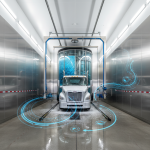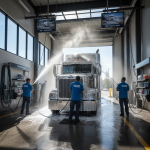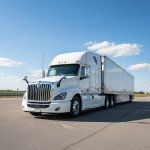Welcome to the ultimate guide for business owners on last mile delivery vehicles! In today’s fast-paced world, efficient and reliable delivery is more important than ever. Whether you run an e-commerce business, a food delivery service, or a logistics company, understanding the ins and outs of last mile delivery vehicles is essential to optimize your operations and delight your customers.
This comprehensive guide will walk you through everything you need to know about last mile delivery vehicles. From choosing the right type of vehicle for your specific business needs, to understanding the latest trends and technologies in the industry, we’ve got you covered. Discover the pros and cons of different vehicle options, learn about eco-friendly alternatives, and get expert tips on maximizing efficiency and reducing costs.
With our expert insights and practical advice, you’ll be able to make informed decisions that will make a significant impact on your delivery operations. Get ready to enhance customer satisfaction, streamline your processes, and stay ahead of the competition with the ultimate guide to last mile delivery vehicles.
Importance of last mile delivery vehicles
The last mile of delivery is often the most challenging and expensive part of the logistics process. It refers to the final leg of the journey where goods are transported from a distribution center or hub to the customer’s doorstep. Last mile delivery vehicles play a crucial role in ensuring that products are delivered quickly, securely, and efficiently. They are the bridge that connects businesses to their customers, making them an indispensable part of the supply chain.
One of the key reasons why last mile delivery vehicles are important is customer satisfaction. In today’s on-demand economy, consumers have high expectations when it comes to delivery speed and convenience. They want their packages to arrive on time and in perfect condition. By using the right type of last mile delivery vehicle, businesses can meet these expectations and provide a positive customer experience. This, in turn, leads to customer loyalty, repeat purchases, and positive word-of-mouth recommendations.
Another reason why last mile delivery vehicles are crucial is cost optimization. The last mile is often the most expensive part of the delivery process, accounting for up to 53% of the total delivery cost. By using the right vehicle, businesses can minimize costs associated with fuel consumption, maintenance, and labor. Additionally, efficient last mile delivery vehicles can help reduce the number of failed delivery attempts, which can be costly in terms of time and resources.
Lastly, last mile delivery vehicles are essential for businesses looking to stay competitive in the digital age. With the rise of e-commerce and the increasing demand for same-day and next-day deliveries, companies that can offer fast and reliable last mile delivery have a distinct advantage over their competitors. Investing in the right vehicles and optimizing delivery operations can be a game-changer for businesses, helping them attract and retain customers in a crowded market.
Types of last mile delivery vehicles
When it comes to last mile delivery, there is no one-size-fits-all solution. The choice of the right vehicle depends on various factors, such as the type of goods being delivered, the distance to be covered, and the specific requirements of the business. Here are some of the most commonly used types of last mile delivery vehicles:
1. Vans: Vans are versatile and widely used for last mile delivery. They come in different sizes, allowing businesses to choose the one that best fits their needs. Small vans are ideal for urban areas with narrow streets, while larger vans can accommodate more goods for longer journeys. Vans offer ample storage space and can be easily customized with shelving or refrigeration units, making them suitable for a wide range of industries.
2. Bicycles: Bicycles are an eco-friendly and cost-effective option for last mile delivery in urban areas. They are particularly popular for food and grocery delivery, as well as for courier services operating in congested city centers. Bicycles can navigate through traffic more easily and can access areas where motor vehicles are restricted. They are also a great way to promote sustainability and reduce carbon emissions.
3. Electric Vehicles: With the increasing focus on sustainability and reducing carbon footprints, electric vehicles (EVs) are gaining popularity in last mile delivery. EVs produce zero emissions, making them an environmentally friendly alternative to traditional gasoline or diesel-powered vehicles. Electric vans and bikes are becoming more widely available, and some cities even offer incentives for businesses to switch to electric delivery vehicles.
4. Motorcycles and Scooters: Motorcycles and scooters are commonly used for last mile delivery in urban areas with heavy traffic. They are agile and can maneuver through congested streets more easily than larger vehicles. Motorcycles and scooters are often favored by courier services and food delivery companies due to their speed and ability to reach customers quickly.
5. Drones: While still in the early stages of development and regulation, drones have the potential to revolutionize last mile delivery. They can bypass traffic and deliver packages directly to customers’ doorsteps, cutting delivery times significantly. Drones are particularly useful for remote or hard-to-reach areas, as well as for urgent deliveries. However, there are still challenges to overcome, such as regulatory restrictions and the need for safe landing zones.
When choosing a last mile delivery vehicle, businesses should consider factors such as the nature of their products, delivery volume, route characteristics, and customer expectations. It’s important to strike a balance between cost, efficiency, environmental impact, and customer satisfaction. By selecting the right vehicle, businesses can optimize their last mile delivery operations and achieve their goals.
Considerations when choosing a last mile delivery vehicle
Choosing the right last mile delivery vehicle is a critical decision that can impact the efficiency and success of your delivery operations. Here are some key considerations to keep in mind when selecting a vehicle:
1. Payload Capacity: The payload capacity of the vehicle refers to the maximum weight it can carry. It’s important to choose a vehicle that can accommodate the volume and weight of your typical deliveries. Overloading a vehicle can lead to safety issues, increased fuel consumption, and potential damage to the goods being transported.
2. Range and Battery Life: For electric vehicles, range and battery life are crucial factors to consider. The range refers to the distance the vehicle can travel on a single charge, while battery life indicates how long the battery can last before needing to be recharged. It’s important to choose a vehicle with sufficient range and battery life to cover your delivery routes without the need for frequent charging.
3. Size and Maneuverability: The size and maneuverability of the vehicle should be compatible with the areas where you operate. If you deliver in urban areas with narrow streets and limited parking spaces, a smaller and more agile vehicle may be more suitable. On the other hand, if you cover larger distances or transport bulky goods, a larger vehicle with more storage capacity may be necessary.
4. Maintenance and Repair: Consider the availability of maintenance and repair services for the chosen vehicle. It’s important to choose a vehicle that is reliable and has a network of service centers or authorized repair shops in your area. Regular maintenance and prompt repairs are essential to keep your delivery operations running smoothly and minimize downtime.
5. Cost: Last but not least, consider the cost of the vehicle, both upfront and ongoing. Evaluate the total cost of ownership, including purchase or lease price, fuel or electricity costs, insurance, maintenance, and potential resale value. It’s important to choose a vehicle that fits within your budget while still meeting your operational requirements.
By carefully considering these factors, businesses can choose a last mile delivery vehicle that aligns with their specific needs and goals. It’s also a good idea to test the vehicle in real-world conditions before making a large-scale investment. Remember, the right vehicle can make a significant difference in the efficiency, cost-effectiveness, and customer satisfaction of your delivery operations.
Cost analysis of last mile delivery vehicles
When it comes to last mile delivery, cost optimization is a top priority for businesses. The choice of the right vehicle can have a significant impact on the overall cost of delivery operations. Here’s a cost analysis of different last mile delivery vehicles to help you make an informed decision:
1. Vans: Vans are a popular choice for last mile delivery due to their versatility and storage capacity. However, they can be expensive to purchase or lease, especially if you opt for larger or specialized models. Additionally, vans require regular fueling or charging, which adds to the ongoing operational costs. It’s important to consider fuel efficiency and maintenance requirements when analyzing the cost of vans for last mile delivery.
2. Bicycles: Bicycles offer a cost-effective solution for last mile delivery, especially in urban areas. They have low upfront costs and require minimal maintenance compared to motor vehicles. The main cost associated with bicycles is the labor involved in pedaling or maintaining an electric-assist system. However, this can be offset by the lower fuel or electricity costs and the potential for faster delivery times in congested areas.
3. Electric Vehicles: Electric vehicles (EVs) can be more expensive upfront compared to traditional gasoline or diesel-powered vehicles. However, they offer long-term cost savings in terms of fuel or electricity costs, as well as reduced maintenance requirements. Depending on the availability of government incentives or tax credits, the cost of EVs can be further reduced. Over time, the cost of EVs is expected to decrease as the technology becomes more widespread.
4. Motorcycles and Scooters: Motorcycles and scooters are generally more affordable than vans or electric vehicles. They have lower upfront costs, require less fuel compared to larger vehicles, and are easier to maintain. However, it’s important to consider factors such as insurance costs, safety equipment, and potential licensing requirements when analyzing the overall cost of motorcycles and scooters for last mile delivery.
5. Drones: While drones offer the potential for faster and more efficient last mile delivery, they can be expensive to implement. The cost of drones themselves can vary depending on the size, range, and payload capacity. Additionally, there are costs associated with training pilots, obtaining necessary licenses and permits, and ensuring compliance with aviation regulations. It’s important to carefully analyze the cost versus the benefits and potential limitations of using drones for last mile delivery.
When conducting a cost analysis, it’s important to consider both the upfront costs and the ongoing operational costs associated with each type of last mile delivery vehicle. Additionally, factors such as fuel efficiency, maintenance requirements, labor costs, and potential government incentives should be taken into account. By comparing the total cost of ownership for different vehicles, businesses can make an informed decision that aligns with their budget and operational needs.
Environmental impact of last mile delivery vehicles
As businesses strive to become more sustainable and reduce their carbon footprints, the environmental impact of last mile delivery vehicles has become a key concern. Here’s a closer look at how different types of vehicles affect the environment:
1. Gasoline and Diesel Vehicles: Traditional gasoline and diesel-powered vehicles are the most commonly used for last mile delivery. However, they contribute to air pollution and greenhouse gas emissions, which have a negative impact on the environment and public health. These vehicles emit carbon dioxide (CO2), nitrogen oxides (NOx), and particulate matter (PM), which contribute to climate change and air quality issues. Additionally, the extraction, refining, and transportation of fossil fuels further add to their environmental impact.
2. Electric Vehicles: Electric vehicles (EVs) offer a more environmentally friendly alternative to gasoline and diesel vehicles. They produce zero tailpipe emissions, meaning they do not emit any harmful pollutants or greenhouse gases during operation. However, the environmental impact of EVs depends on the source of electricity used for charging. If the electricity comes from renewable sources such as solar or wind, the overall environmental impact is significantly reduced. Charging infrastructure and battery disposal or recycling are other important factors to consider when assessing the environmental impact of EVs.
3. Bicycles: Bicycles are the most sustainable option for last mile delivery. They produce zero emissions and have a minimal environmental impact compared to motor vehicles. By using bicycles for delivery, businesses can reduce their carbon footprint, improve air quality, and promote a healthier and more active lifestyle. Additionally, bicycles do not contribute to noise pollution, making them ideal for deliveries in residential areas or during quiet hours.
4. Drones: Drones are still in the early stages of development and implementation for last mile delivery. While they offer the potential for faster and more efficient deliveries, their environmental impact is not yet fully understood. Drones powered by electricity have the advantage of zero emissions during operation. However, the manufacturing and disposal of drone components, as well as the potential for noise pollution, need to be considered when assessing their environmental impact.
To minimize the environmental impact of last mile delivery, businesses can adopt several strategies. These include transitioning to electric vehicles, promoting the use of bicycles or other non-motorized vehicles for short-distance deliveries, optimizing delivery routes to reduce mileage and fuel consumption, and exploring alternative energy sources such as solar or hydrogen for charging or powering vehicles. Implementing eco-friendly practices not only benefits the environment but also enhances a company’s reputation and attracts environmentally conscious customers.
Best practices for managing last mile delivery vehicles
Efficient management of last mile delivery vehicles is crucial for optimizing operations and meeting customer expectations. Here are some best practices to consider:
1. Route Optimization: Invest in route optimization software or tools to plan the most efficient delivery routes. By minimizing mileage and reducing unnecessary stops or backtracking, businesses can save time and fuel, leading to cost savings and improved customer satisfaction. Route optimization also helps reduce traffic congestion and carbon emissions.
2. Real-Time Tracking: Implement real-time tracking systems to monitor the location and status of delivery vehicles. This allows businesses to provide accurate delivery updates to customers and address any potential issues proactively. Real-time tracking also helps optimize routes, identify bottlenecks, and improve overall operational efficiency.
3. Safety Measures: Prioritize driver and road safety by implementing safety measures such as driver training programs, regular vehicle maintenance, and adherence to traffic laws. Safe driving practices not only protect the well-being of drivers and other road users but also reduce the risk of accidents, delays, and damage to goods.
4. Efficient Loading and Unloading: Streamline the loading and unloading processes to minimize idle time and maximize productivity. Use efficient loading techniques, such as the “last in, first out” principle, to ensure quick access to goods. Consider investing in loading/unloading equipment or technologies that can expedite these tasks.
5. Inventory Management: Implement robust inventory management systems to track stock levels, monitor product expiration dates (if applicable), and ensure accurate order fulfillment. Effective inventory management reduces
Technology and innovation in last mile delivery vehicles
Managing last mile delivery vehicles efficiently is crucial for any business relying on timely and reliable deliveries. To ensure smooth operations, it’s important to implement best practices that optimize your fleet’s performance. Here are some key practices to consider:
1. Route optimization: Planning efficient delivery routes can significantly reduce travel time and fuel consumption. Utilize route planning software or GPS systems that take into account traffic conditions, delivery time windows, and customer preferences. By optimizing routes, you can minimize mileage and increase the number of deliveries per day.
2. Vehicle maintenance: Regular maintenance and inspections are essential to keep your vehicles in optimal condition. Implement a preventative maintenance schedule that includes routine checks on tires, brakes, fluids, and other key components. This will help prevent breakdowns and ensure that your fleet is always ready to hit the road.
3. Driver training: Well-trained drivers are crucial for safe and efficient deliveries. Provide comprehensive training programs that cover defensive driving techniques, customer service skills, and proper handling of goods. Encourage drivers to report any issues or suggestions for improvement, fostering a culture of continuous learning and development.
By implementing these best practices, you can significantly enhance the efficiency and reliability of your last mile delivery operations. Taking the time to optimize your fleet management processes will lead to improved customer satisfaction and increased profitability.
Case studies of successful last mile delivery vehicle implementation
The world of last mile delivery vehicles is rapidly evolving, thanks to advancements in technology and innovative solutions. These developments are revolutionizing the way businesses approach deliveries, bringing about increased efficiency and improved customer experiences. Let’s explore some of the key technologies and innovations shaping the industry:
1. Electric vehicles (EVs): With the growing emphasis on sustainability and reducing carbon emissions, electric vehicles have gained significant popularity in the last mile delivery sector. EVs offer lower operational costs, reduced environmental impact, and access to restricted emission zones. As battery technology improves, the range and charging times of electric delivery vehicles are becoming more practical for businesses.
2. Autonomous vehicles: While still in the testing and development phase, autonomous vehicles have the potential to transform last mile delivery operations. Self-driving vehicles can operate 24/7, reducing labor costs and improving delivery speed. However, regulatory challenges and safety concerns need to be addressed before widespread adoption can occur.
3. Real-time tracking: Real-time tracking systems enable businesses and customers to track the location and estimated arrival time of their deliveries. This transparency not only improves customer satisfaction but also allows for better planning and coordination of delivery schedules. By providing accurate and up-to-date information, businesses can proactively address any potential delays or issues.
These are just a few examples of the technological advancements driving innovation in the last mile delivery vehicle industry. As technology continues to evolve, so do the opportunities for businesses to optimize their delivery processes and stay ahead of the competition.
Conclusion: The future of last mile delivery vehicles
To truly understand the impact and potential of last mile delivery vehicles, let’s explore some real-world case studies of successful implementation:
1. Amazon: As one of the largest e-commerce companies in the world, Amazon has been at the forefront of last mile delivery innovation. They have invested heavily in their own delivery fleet, including a mix of vans, trucks, and even drones. By utilizing advanced routing algorithms and real-time tracking systems, Amazon has been able to offer fast and reliable deliveries to millions of customers worldwide.
2. Uber Eats: The rise of food delivery services has also led to innovative approaches in last mile delivery. Uber Eats, for example, uses a network of independent drivers to facilitate food deliveries. Their app-based platform connects restaurants, delivery drivers, and customers, providing a seamless and efficient delivery experience.
3. DHL: DHL, one of the world’s largest logistics companies, has been exploring alternative delivery methods to tackle the challenges of urban congestion. In some cities, they have successfully implemented cargo bikes and electric scooters for smaller deliveries, reducing their carbon footprint and improving delivery speed in densely populated areas.
These case studies highlight the diverse strategies and solutions that businesses have employed to optimize their last mile delivery operations. By studying successful implementations, you can gain valuable insights into how to adapt and improve your own delivery processes.




